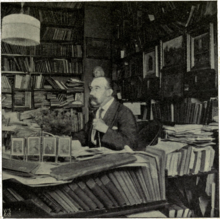Moltke Moe
Moltke Moe , Ingebret Moltke Moe, (born June 19, 1859 in Krødsherad , † December 15, 1913 in Kristiania ) was a Norwegian folklorist.
Life
His parents were the bishop Jørgen Moe (1813-1882) and his wife Johanne Fredrikke Sophie Sørenssen (1833-1913). He remained unmarried.
Moe grew up in Krødsherad, Drammen and Vestre Aker near Christiania. As a young student he worked for Peter Christen Asbjørnsen and after his death in 1885 took over the publication of his collection of fairy tales and his father's collection of fairy tales and legends. After he had passed his exams artium in 1876, he began to study theology, where he dealt particularly with comparative religious history. But soon he was only interested in customs and the history of religion and gave up theology. The only exam he took was the Examen philosophicum. He soon received a scholarship from the university for a long research trip to Telemark , where he was supposed to collect the old folk tales. With a scholarship from the Storting , he undertook two further research trips from 1882 to 1886 and from 1889 to 1891 with rich yield. In 1886 he became professor for the Norwegian vernacular with compulsory lectures for Norwegian traditions. He wasn't a linguist. When a separate chair for Landsmål was set up in 1899 , his chair was renamed “Folk traditions, medieval literature including Old Norse-Icelandic”. From 1889 to 1900 he sat on the board of directors of the publishing house "Det Norske Samlaget" and on the editorial team of Syn og Segn .
Great expectations were attached to his scientific work. But he wrote relatively few papers. With the increase in his knowledge, his self-criticism and the endeavor to illuminate a research subject from as many angles as possible grew. He was also sickly and involved in many projects, such as "Det norske Samlaget", the writers' association that he helped to build, "Norsk Folkemuseum", "Rolfsens lesebok" and the magazine Norvegia . He lacked any scientific ambition, so Arne Garborg proposed to found an "Association for the protection of Moltke Moes". His work was often out of date when it was published. In researching fairy tales he traced the connection with mythology, later the cultural transfer and the hiking trails of the motifs. Here he published short but important articles on Hellenic and Norwegian folk traditions, the migration of fairy tales and commentaries on individual fairy tales. The introductions to Qvigstad and Sandberg's Sami fairy tales earned him international recognition.
In folk song research he dealt with fundamental questions about the origin and history of the Norwegian ballad. But it was not until 1912 that he published a brief summary of his theories in an introduction to the school edition Norske folkeviser fra middelalderen which he wrote together with his student Knut Liestøl . His great dream of a scientific edition of the Norwegian ballads was never realized. With the help of Sophus Bugge he managed to publish the Thors-Weisen (Torsvisa) with a complete scientific apparatus. His school edition and the popular edition of Norwegian folk songs shaped the view of this literary genre for decades. On behalf of Asbjørnsen, he continued the Norwegianization of fairy tale and saga texts and made them popular. He also participated in the spelling debate and promoted the Norwegianization of Riksmål in the 1907 spelling reform. His vision was that Landsmål and Riksmål would merge into one whole Norwegian.
His large collection of manuscripts, together with that of his father and the Asbjørnsens collection, formed the basis of the national folklore archive “Norsk folkeminnesamling”.
Works (selection)
- Pick up scripters . 3 vol., Edited by K. Liestøl, Instituttet for sammenlignende kulturforskning. Series B 1, 6 and 9, 1925-1927.
- Norske fornkvæde og folkevisur (together with Ivar Mortensson-Egnund) 1877.
- "Hellenske og norske folketraditioner" in: Nordisk tidskrift . 1879
- Lappiske eventyr og sagn (collected by Qvigstad and Sandberg), 1887
- "Torsvisen i sin norske form". Published with a treatise on its origin and its relationship to other Scandinavian forms (together with Sophus Bugge), Festskrift til H. Maj.Kong Oscar II ved Regjerings-Jubilæet on September 18, 1897 from Det kongelige Frederiks Universitet , 1897
- Retskrivning and folkedannelse (1900)
- Norsk og dansk sprogdagt. Retskrivningssakens vei og tempo (1906)
- Folkeminne frå Bøherad , (Ed. K. Liestøl), Norsk folkeminnelags reprints 9, 1925
- Folke-eventyr frå Flatdal , (Ed. N. Lid) Norsk folkeminnelags reprints 20, 1929
Remarks
- ↑ The "Examen artium" was the regular entrance examination for university, which required knowledge of Latin and Greek. So it corresponded to the Abitur, but was accepted by the university until 1883.
- ↑ KV Hammer: Ingebret Moltke M. In: Theodor Westrin (Ed.): Nordisk familjebok konversationslexikon och realencyklopedi . 2nd Edition. tape 18 : Mekaniker – Mycale . Nordisk familjeboks förlag, Stockholm 1913, Sp. 795 (Swedish, runeberg.org ).
- ↑ The Examen philosophicum was the completion of the Studium Generale and a prerequisite for further studies in a certain subject.
- ↑ a b c Jon Grepstad: Moltke Moe . In: alkunne Nynorsk cultural history
literature
- Reimund Kvideland: Moltke Moe . In: Norsk biografisk leksikon
- Jon Grepstad: Moltke Moe . In: alkunne Nynorsk cultural history
Web links
| personal data | |
|---|---|
| SURNAME | Moe, Moltke |
| ALTERNATIVE NAMES | Moe, Moltke Ingebret |
| BRIEF DESCRIPTION | Norwegian folklorist |
| DATE OF BIRTH | June 19, 1859 |
| PLACE OF BIRTH | Krødsherad |
| DATE OF DEATH | December 15, 1913 |
| Place of death | Kristiania |

